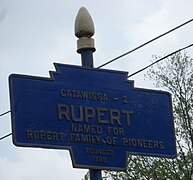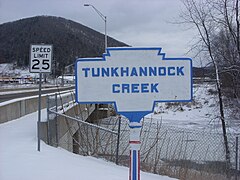Keystone Markers


Keystone Markers are a distinctive system of signs on the edge of Pennsylvania roads , developed by the Pennsylvania Department of Highways immediately after World War I , and placed at the entrances to every town , borough and city . Variations of the markers were set up at crossings of streams, rivers, trails, city limits and other sights.
overview
The Keystone Markers were introduced at the height of the Good Roads Movement , which opened up country road travel to the masses. The Keystone Markers were an initiative of the Department of Highways, the predecessor of today's Pennsylvania Department of Traffic (PennDOT). The designation of Pennsylvania as the "Keystone State" was established by the widespread use of blue and yellow cast iron signs.
There were once thousands of keystone markers in Pennsylvania, around 600 of which have survived. The loss of the markers prompted Preservation Pennsylvania, a state-owned monument protection organization, to put the Keystone Markers on their 2011 list of Most Endangered Resources. City keystone markers are the largest group of preserved markers. In the cities with such markers, at least two of them were placed on the main streets on each side of the city. When a town was at the intersection of two highways, four such signs were put up. The markers for cities included the city's name, the reason for naming it, and the date it was founded. Most of the time, the distance to the nearest town was also given in the upper part of the sign. Therefore, each of these markers was unique to a city.
variants
There are three different Keystone Markers, each generally designed for different uses.
- One-sided signs mounted on the front of a post and intended for marking cities.
- Two-sided signs that are mounted on special posts and can be read from both directions and are therefore used to mark watercourses.
- Keystone Variant Markers are used on city limits, trails, points of interest, and to mark county roads and local roads.
Keystone Marker Trust
The non-profit Keystone Marker Trust is working with PennDOT and local governments across the Commonwealth to restore the existing Keystone Markers. The Trust was founded by two members of the National Railway Historical Society , the Anwal Nathaniel Guest and the historian Greg Prichard.
gallery
Historically accurate
Keystone marker for Cleona before restoration (2003)
Damaged or historically inaccurate
Keystone marker cemented into a wall for Daggett
Atypical color scheme for a keystone marker in North East .
Badly damaged keystone marker in Robesonia
supporting documents
- ↑ a b Graham, John: A Welcoming Sign . In: Pennsylvania Borough News , June 2010. Archived from the original on August 26, 2014 Info: The archive link was inserted automatically and has not yet been checked. Please check the original and archive link according to the instructions and then remove this notice. . Retrieved November 24, 2016.
- ↑ Graham, John T: History in Cast Iron Archived from the original on August 26, 2014. Info: The archive link was automatically inserted and not yet checked. Please check the original and archive link according to the instructions and then remove this notice. In: Pennsylvania Recreation and Parks Magazine . No. Second Quarter 2010, 2010. Retrieved November 24, 2016.
- ↑ a b c Weaver, Stephanie: Refurbished Signs Making Their Mark in Birdsboro . In: The Reading Eagle , April 9, 2012. Archived from the original on February 20, 2014 Info: The archive link was inserted automatically and has not yet been checked. Please check the original and archive link according to the instructions and then remove this notice. . Retrieved November 24, 2016.
- ^ Gustafson, Randy: Historic Keystone Signs get new life . In: Times Observer , March 17, 2012. Archived from the original on February 20, 2014 Info: The archive link was inserted automatically and has not yet been checked. Please check the original and archive link according to the instructions and then remove this notice. . Retrieved November 24, 2016.
- ^ Preservation Pennsylvania ( English , PDF) Preservation Pennsylvania 2011. 2011. Retrieved November 24, 2016.
- ^ A b Graham, Jack: The Cast Iron Town Signs of Pennsylvania . In: Lancaster Farming , March 26, 2011. ( Page no longer available , search in web archives ) Info: The link was automatically marked as defective. Please check the link according to the instructions and then remove this notice.
- ^ Birdsboro, the only municipality to have three types of Keystone Markers . In: The Reading Eagle , April 9, 2012. ( Page no longer available , search in web archives ) Info: The link was automatically marked as defective. Please check the link according to the instructions and then remove this notice.
- ^ Pennsylvania Keystone Markers ... Symbols of our Past and Bright Future ( English , PDF) TREDYFFRIN HISTORIC PRESERVATION TRUST. 2013. Retrieved November 24, 2016.
Web links
- Keystone Marker Trust homepage
- Mark D. Marotta: Preserving a bit of Pennsylvania history . In: Pottstown Mercury , May 24, 2013.
- Mary Ann Thomas: Keystone Markers give insights about towns but have fallen victim to time, theft or traffic accidents . In: Pittsburgh Tribune-Review , July 5, 2015.











